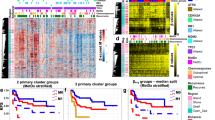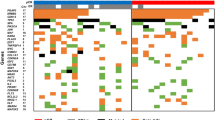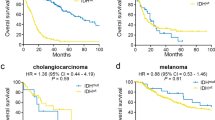Abstract
Glioblastoma, the most aggressive and least treatable form of malignant glioma, is the most common human brain tumor. Although many regions of allelic loss occur in glioblastomas, relatively few tumor suppressor genes have been found mutated at such loci. To address the possibility that epigenetic alterations are an alternative means of glioblastoma gene inactivation, we coupled pharmacological manipulation of methylation with gene profiling to identify potential methylation-regulated, tumor-related genes. Duplicates of three short-term cultured glioblastomas were exposed to 5 μ M 5-aza-dC for 96 h followed by cRNA hybridization to an oligonucleotide microarray (Affymetrix U133A). We based candidate gene selection on bioinformatics, reverse transcription-polymerase chain reaction (RT–PCR), bisulfite sequencing, methylation-specific PCR and matrix-assisted laser desorption/ionization time-of-flight mass spectrometry. Two genes identified in this manner, RUNX3 and Testin (TES), were subsequently shown to harbor frequent tumor-specific epigenetic alterations in primary glioblastomas. This overall approach therefore provides a powerful means to identify candidate tumor-suppressor genes for subsequent evaluation and may lead to the identification of genes whose epigenetic dysregulation is integral to glioblastoma tumorigenesis.
This is a preview of subscription content, access via your institution
Access options
Subscribe to this journal
Receive 50 print issues and online access
$259.00 per year
only $5.18 per issue
Buy this article
- Purchase on Springer Link
- Instant access to full article PDF
Prices may be subject to local taxes which are calculated during checkout




Similar content being viewed by others
References
Ballestar E, Esteller M . (2005). The epigenetic breakdown of cancer cells: from DNA methylation to histone modifications. Prog Mol Subcell Biol 38: 169–181.
Bhatia K, Siraj AK, Hussain A, Bu R, Gutierrez MI . (2003). The tumor suppressor gene 14-3-3 sigma is commonly methylated in normal and malignant lymphoid cells. Cancer Epidemiol Biomarkers Prev 12: 165–169.
Blan JL, Wager M, Guilhot J, Kusy S, Bataille B, Chantereau T et al. (2004). Correlation of clinical features and methylation status of MGMT gene promoter in glioblastomas. J Neurooncol 68: 275–283.
Ching TT, Maunakea AK, Jun P, Hong C, Zardo G, Pinkel D et al. (2005). Epigenome analyses using BAC microarrays identify evolutionary conservation of tissue-specific methylation of SHANK3. Nat Genet 37: 645–651.
Chung R, Whaley J, Kley N, Anderson K, Louis D, Menon A et al. (1991). TP53 gene mutations and 17p deletions in human astrocytomas. Genes Chromosomes Cancer 3: 323–331.
Collins VP . (2004). Brain tumours: classification and genes. J Neurol Neurosurg Psychiatry 75 (Suppl 2): ii2–ii11.
Costello JF, Berger MS, Huang HS, Cavenee WK . (1996). Silencing of p16/CDKN2 expression in human gliomas by methylation and chromatin condensation. Cancer Res 56: 2405–2410.
Costello JF, Fruhwald MC, Smiraglia DJ, Rush LJ, Robertson GP, Gao X et al. (2000a). Aberrant CpG-island methylation has non-random and tumour-type-specific patterns. Nat Genet 24: 132–138.
Costello JF, Plass C, Cavenee WK . (2000b). Aberrant methylation of genes in low-grade astrocytomas. Brain Tumor Pathol 17: 49–56.
Costello JF, Plass C, Cavenee WK . (2002a). Restriction landmark genome scanning. Methods Mol Biol 200: 53–70.
Costello JF, Smiraglia DJ, Plass C . (2002b). Restriction landmark genome scanning. Methods 27: 144–149.
Curtis CD, Goggins M . (2005). DNA methylation analysis in human cancer. Methods Mol Med 103: 123–136.
Dallol A, Krex D, Hesson L, Eng C, Maher ER, Latif F . (2003). Frequent epigenetic inactivation of the SLIT2 gene in gliomas. Oncogene 22: 4611–4616.
Dickinson RE, Dallol A, Bieche I, Krex D, Morton D, Maher ER et al. (2004). Epigenetic inactivation of SLIT3 and SLIT1 genes in human cancers. Br J Cancer 91: 2071–2078.
Domann FE, Rice JC, Hendrix MJ, Futscher BW . (2000). Epigenetic silencing of maspin gene expression in human breast cancers. Int J Cancer 85: 805–810.
Ehrich M, Nelson MR, Stanssens P, Zabeau M, Liloglou T, Xinarianos G et al. (2005). Quantitative high-throughput analysis of DNA methylation patterns by base-specific cleavage and mass spectrometry. Proc Natl Acad Sci USA 102: 15785–15790.
Esteller M . (2003). Cancer epigenetics: DNA methylation and chromatin alterations in human cancer. Adv Exp Med Biol 532: 39–49.
Esteller M . (2005). Aberrant DNA methylation as a cancer-inducing mechanism. Annu Rev Pharmacol Toxicol 45: 629–656.
Esteller M, Hamilton SR, Burger PC, Baylin SB, Herman JG . (1999). Inactivation of the DNA repair gene O6-methylguanine-DNA methyltransferase by promoter hypermethylation is a common event in primary human neoplasia. Cancer Res 59: 793–797.
Fan X, Munoz J, Sanko SG, Castresana JS . (2002). PTEN, DMBT1, and p16 alterations in diffusely infiltrating astrocytomas. Int J Oncol 21: 667–674.
Futscher BW, Oshiro MM, Wozniak RJ, Holtan N, Hanigan CL, Duan H et al. (2002). Role for DNA methylation in the control of cell type specific maspin expression. Nat Genet 31: 175–179.
Gasco M, Bell AK, Heath V, Sullivan A, Smith P, Hiller L et al. (2002). Epigenetic inactivation of 14-3-3 sigma in oral carcinoma: association with p16(INK4a) silencing and human papillomavirus negativity. Cancer Res 62: 2072–2076.
Gonzalez-Gomez P, Bello MJ, Arjona D, Lomas J, Alonso ME, De Campos JM et al. (2003a). Promoter hypermethylation of multiple genes in astrocytic gliomas. Int J Oncol 22: 601–608.
Gonzalez-Gomez P, Bello MJ, Lomas J, Arjona D, Alonso ME, Aminoso C et al. (2003b). Epigenetic changes in pilocytic astrocytomas and medulloblastomas. Int J Mol Med 11: 655–660.
Hegi ME, Diserens AC, Godard S, Dietrich PY, Regli L, Ostermann S et al. (2004). Clinical trial substantiates the predictive value of O-6-methylguanine-DNA methyltransferase promoter methylation in glioblastoma patients treated with temozolomide. Clin Cancer Res 10: 1871–1874.
Hegi ME, Diserens AC, Gorlia T, Hamou MF, de Tribolet N, Weller M et al. (2005). MGMT gene silencing and benefit from temozolomide in glioblastoma. N Engl J Med 352: 997–1003.
Henson JW, Schnitker BL, Correa KM, von Deimling A, Fassbender F, Xu HJ et al. (1994). The retinoblastoma gene is involved in malignant progression of astrocytomas. Ann Neurol 36: 714–721.
Herman JG, Graff JR, Myohanen S, Nelkin BD, Baylin SB . (1996). Methylation-specific PCR: a novel PCR assay for methylation status of CpG islands. Proc Natl Acad Sci USA 93: 9821–9826.
Hill C, Hunter SB, Brat DJ . (2003). Genetic markers in glioblastoma: prognostic significance and future therapeutic implications. Adv Anat Pathol 10: 212–217.
Hong C, Bollen AW, Costello JF . (2003). The contribution of genetic and epigenetic mechanisms to gene silencing in oligodendrogliomas. Cancer Res 63: 7600–7605.
Ichimura K, Bolin MB, Goike HM, Schmidt EE, Moshref A, Collins VP . (2000). Deregulation of the p14ARF/MDM2/p53 pathway is a prerequisite for human astrocytic gliomas with G1-S transition control gene abnormalities. Cancer Res 60: 417–424.
Ichimura K, Schmidt EE, Goike HM, Collins VP . (1996). Human glioblastomas with no alterations of the CDKN2A (p16INK4A, MTS1) and CDK4 genes have frequent mutations of the retinoblastoma gene. Oncogene 13: 1065–1072.
Imamura Y, Hibi K, Koike M, Fujiwara M, Kodera Y, Ito K et al. (2005). RUNX3 promoter region is specifically methylated in poorly-differentiated colorectal cancer. Anticancer Res 25: 2627–2630.
Ino Y, Zlatescu MC, Sasaki H, Macdonald DR, Stemmer-Rachamimov AO, Jhung S et al. (2000). Long survival and therapeutic responses in patients with histologically disparate high-grade gliomas demonstrating chromosome 1p loss. J Neurosurg 92: 983–990.
Jain PK . (2003). Epigenetics: the role of methylation in the mechanism of action of tumor suppressor genes. Ann NY Acad Sci 983: 71–83.
Jeanteur P . (2000). 14-3-3sigma (stratifin), a potential tumor suppressor frequently inactivated by methylation in cancer of the breast. Bull Cancer 87: 525.
Kamiryo T, Tada K, Shiraishi S, Shinojima N, Kochi M, Ushio Y . (2004). Correlation between promoter hypermethylation of the O6-methylguanine-deoxyribonucleic acid methyltransferase gene and prognosis in patients with high-grade astrocytic tumors treated with surgery, radiotherapy, and 1-(4-amino-2-methyl-5-pyrimidinyl)methyl-3-(2-chloroethyl)-3-nitrosourea-b ased chemotherapy. Neurosurgery 54: 349–357; discussion 357.
Kang GH, Lee S, Lee HJ, Hwang KS . (2004). Aberrant CpG island hypermethylation of multiple genes in prostate cancer and prostatic intraepithelial neoplasia. J Pathol 202: 233–240.
Kato N, Tamura G, Fukase M, Shibuya H, Motoyama T . (2003). Hypermethylation of the RUNX3 gene promoter in testicular yolk sac tumor of infants. Am J Pathol 163: 387–391.
Kim DH, Mohapatra G, Bollen A, Waldman FM, Feuerstein BG . (1995). Chromosomal abnormalities in glioblastoma multiforme tumors and glioma cell lines detected by comparative genomic hybridization. Int J Cancer 60: 812–819.
Kim TY, Lee HJ, Hwang KS, Lee M, Kim JW, Bang YJ et al. (2004). Methylation of RUNX3 in various types of human cancers and premalignant stages of gastric carcinoma. Lab Invest 84: 479–484.
Kleihues P, Cavenee WK . (2000). Pathology and Genetics of Tumours of the Nervous System. IARC Press: Lyon.
Kohno T, Kawanishi M, Inazawa J, Yokota J . (1998). Identification of CpG islands hypermethylated in human lung cancer by the arbitrarily primed-PCR method. Hum Genet 102: 258–264.
Li J, Yen C, Liaw D, Podsypanina K, Bose S, Wang SI et al. (1997). PTEN, a putative protein tyrosine phosphatase gene mutated in human brain, breast, and prostate cancer. Science 275: 1943–1947.
Li Q, Ahuja N, Burger PC, Issa JP . (1999). Methylation and silencing of the thrombospondin-1 promoter in human cancer. Oncogene 18: 3284–3289.
Li Q, Jedlicka A, Ahuja N, Gibbons MC, Baylin SB, Burger PC et al. (1998). Concordant methylation of the ER and N33 genes in glioblastoma multiforme. Oncogene 16: 3197–3202.
Li QL, Ito K, Sakakura C, Fukamachi H, Inoue K, Chi XZ et al. (2002). Causal relationship between the loss of RUNX3 expression and gastric cancer. Cell 109: 113–124.
Li QL, Kim HR, Kim WJ, Choi JK, Lee YH, Kim HM et al. (2004). Transcriptional silencing of the RUNX3 gene by CpG hypermethylation is associated with lung cancer. Biochem Biophys Res Commun 314: 223–228.
Liang G, Salem CE, Yu MC, Nguyen HD, Gonzales FA, Nguyen TT et al. (1998). DNA methylation differences associated with tumor tissues identified by genome scanning analysis. Genomics 53: 260–268.
Lodygin D, Epanchintsev A, Menssen A, Diebold J, Hermeking H . (2005). Functional epigenomics identifies genes frequently silenced in prostate cancer. Cancer Res 65: 4218–4227.
Louis DN . (2006). Molecular pathology of malignant gliomas. Annu Rev Pathol Mech Dis 1: 97–117.
Matsumura T, Malik F, Holliday R . (1989). Levels of DNA methylation in diploid and SV40 transformed human fibroblasts. Exp Gerontol 24: 477–481.
Mohapatra G, Bollen AW, Kim DH, Lamborn K, Moore DH, Prados MD et al. (1998). Genetic analysis of glioblastoma multiforme provides evidence for subgroups within the grade. Genes Chromosomes Cancer 21: 195–206.
Mori T, Nomoto S, Koshikawa K, Fujii T, Sakai M, Nishikawa Y et al. (2005). Decreased expression and frequent allelic inactivation of the RUNX3 gene at 1p36 in human hepatocellular carcinoma. Liver Int 25: 380–388.
Morris MR, Gentle D, Abdulrahman M, Maina EN, Gupta K, Banks RE et al. (2005). Tumor suppressor activity and epigenetic inactivation of hepatocyte growth factor activator inhibitor type 2/SPINT2 in papillary and clear cell renal cell carcinoma. Cancer Res 65: 4598–4606.
Nishizaki T, Ozaki S, Harada K, Ito H, Arai H, Beppu T et al. (1998). Investigation of genetic alterations associated with the grade of astrocytic tumor by comparative genomic hybridization. Genes Chromosomes Cancer 21: 340–346.
Osada H, Tatematsu Y, Yatabe Y, Nakagawa T, Konishi H, Harano T et al. (2002). Frequent and histological type-specific inactivation of 14-3-3sigma in human lung cancers. Oncogene 21: 2418–2424.
Sarti M, Sevignani C, Calin GA, Aqeilan R, Shimizu M, Pentimalli F et al. (2005). Adenoviral transduction of TESTIN gene into breast and uterine cancer cell lines promotes apoptosis and tumor reduction in vivo. Clin Cancer Res 11: 806–813.
Sato N, Fukushima N, Matsubayashi H, Goggins M . (2004). Identification of maspin and S100P as novel hypomethylation targets in pancreatic cancer using global gene expression profiling. Oncogene 23: 1531–1538.
Schmidt MC, Antweiler S, Urban N, Mueller W, Kuklik A, Meyer-Puttlitz B et al. (2002). Impact of genotype and morphology on the prognosis of glioblastoma. J Neuropathol Exp Neurol 61: 321–328.
Schulmann K, Sterian A, Berki A, Yin J, Sato F, Xu Y et al. (2005). Inactivation of p16, RUNX3, and HPP1 occurs early in Barrett's-associated neoplastic progression and predicts progression risk. Oncogene 24: 4138–4148.
Smiraglia DJ, Fruhwald MC, Costello JF, McCormick SP, Dai Z, Peltomaki P et al. (1999). A new tool for the rapid cloning of amplified and hypermethylated human DNA sequences from restriction landmark genome scanning gels. Genomics 58: 254–262.
Stanssens P, Zabeau M, Meersseman G, Remes G, Gansemans Y, Storm N et al. (2004). High-throughput MALDI-TOF discovery of genomic sequence polymorphisms. Genome Res 14: 126–133.
Steck PA, Pershouse MA, Jasser SA, Yung WK, Lin H, Ligon AH et al. (1997). Identification of a candidate tumour suppressor gene, MMAC1, at chromosome 10q23.3 that is mutated in multiple advanced cancers. Nat Genet 15: 356–362.
Stone AR, Bobo W, Brat DJ, Devi NS, Van Meir EG, Vertino PM . (2004). Aberrant methylation and down-regulation of TMS1/ASC in human glioblastoma. Am J Pathol 165: 1151–1161.
Suzuki H, Itoh F, Toyota M, Kikuchi T, Kakiuchi H, Imai K . (2000). Inactivation of the 14-3-3 sigma gene is associated with 5′ CpG island hypermethylation in human cancers. Cancer Res 60: 4353–4357.
Tatarelli C, Linnenbach A, Mimori K, Croce CM . (2000). Characterization of the human TESTIN gene localized in the FRA7G region at 7q31.2. Genomics 68: 1–12.
Tobias ES, Hurlstone AF, MacKenzie E, McFarlane R, Black DM . (2001). The TES gene at 7q31.1 is methylated in tumours and encodes a novel growth-suppressing LIM domain protein. Oncogene 20: 2844–2853.
Tozawa T, Tamura G, Honda T, Nawata S, Kimura W, Makino N et al. (2004). Promoter hypermethylation of DAP-kinase is associated with poor survival in primary biliary tract carcinoma patients. Cancer Sci 95: 736–740.
Ueki K, Ono Y, Henson JW, Efird JT, von Deimling A, Louis DN . (1996). CDKN2/p16 or RB alterations occur in the majority of glioblastomas and are inversely correlated. Cancer Res 56: 150–153.
Umbricht CB, Evron E, Gabrielson E, Ferguson A, Marks J, Sukumar S . (2001). Hypermethylation of 14-3-3 sigma (stratifin) is an early event in breast cancer. Oncogene 20: 3348–3353.
von Deimling A, Fimmers R, Schmidt MC, Bender B, Fassbender F, Nagel J et al. (2000). Comprehensive allelotype and genetic anaysis of 466 human nervous system tumors. J Neuropathol Exp Neurol 59: 544–558.
von Deimling A, Louis DN, Schramm J, Wiestler OD . (1994). Astrocytic gliomas: characterization on a molecular genetic basis. Recent Results Cancer Res 135: 33–42.
Wang SI, Puc J, Li J, Bruce JN, Cairns P, Sidransky D et al. (1997). Somatic mutations of PTEN in glioblastoma multiforme. Cancer Res 57: 4183–4186.
Watanabe T, Huang H, Nakamura M, Wischhusen J, Weller M, Kleihues P et al. (2002). Methylation of the p73 gene in gliomas. Acta Neuropathol (Berl) 104: 357–362.
Wei D, Gong W, Oh SC, Li Q, Kim WD, Wang L et al. (2005). Loss of RUNX3 expression significantly affects the clinical outcome of gastric cancer patients and its restoration causes drastic suppression of tumor growth and metastasis. Cancer Res 65: 4809–4816.
Wooten EC, Fults D, Duggirala R, Williams K, Kyritsis AP, Bondy ML et al. (1999). A study of loss of heterozygosity at 70 loci in anaplastic astrocytoma and glioblastoma multiforme with implications for tumor evolution. Neuro-oncol 1: 169–176.
Xiao WH, Liu WW . (2004). Hemizygous deletion and hypermethylation of RUNX3 gene in hepatocellular carcinoma. World J Gastroenterol 10: 376–380.
Yamashita K, Upadhyay S, Osada M, Hoque MO, Xiao Y, Mori M et al. (2002). Pharmacologic unmasking of epigenetically silenced tumor suppressor genes in esophageal squamous cell carcinoma. Cancer Cell 2: 485–495.
Zardo G, Tiirikainen MI, Hong C, Misra A, Feuerstein BG, Volik S et al. (2002). Integrated genomic and epigenomic analyses pinpoint biallelic gene inactivation in tumors. Nat Genet 32: 453–458.
Acknowledgements
This work was supported by NIH CA57683 and Deutsche Forschungsgemeinschaft MU 1777 1-1. We thank Joe Costello, Therese Visted, Sean Lawler and Kazue Kasai for their technical advice and helpful discussions.
Author information
Authors and Affiliations
Corresponding author
Additional information
Supplementary Information accompanies the paper on the Oncogene website (http://www.nature.com/onc).
Supplementary information
Rights and permissions
About this article
Cite this article
Mueller, W., Nutt, C., Ehrich, M. et al. Downregulation of RUNX3 and TES by hypermethylation in glioblastoma. Oncogene 26, 583–593 (2007). https://doi.org/10.1038/sj.onc.1209805
Received:
Revised:
Accepted:
Published:
Issue Date:
DOI: https://doi.org/10.1038/sj.onc.1209805
Keywords
This article is cited by
-
Comprehensive analysis of epigenetics regulation, prognostic and the correlation with immune infiltrates of GPX7 in adult gliomas
Scientific Reports (2022)
-
Silencing of Testin expression is a frequent event in spontaneous lymphomas from Trp53-mutant mice
Scientific Reports (2020)
-
TES functions as a Mena‐dependent tumor suppressor in gastric cancer carcinogenesis and metastasis
Cancer Communications (2019)
-
The Role of Testin in Human Cancers
Pathology & Oncology Research (2019)
-
RUNX3 inhibits glioma survival and invasion via suppression of the β-catenin/TCF-4 signaling pathway
Journal of Neuro-Oncology (2018)



